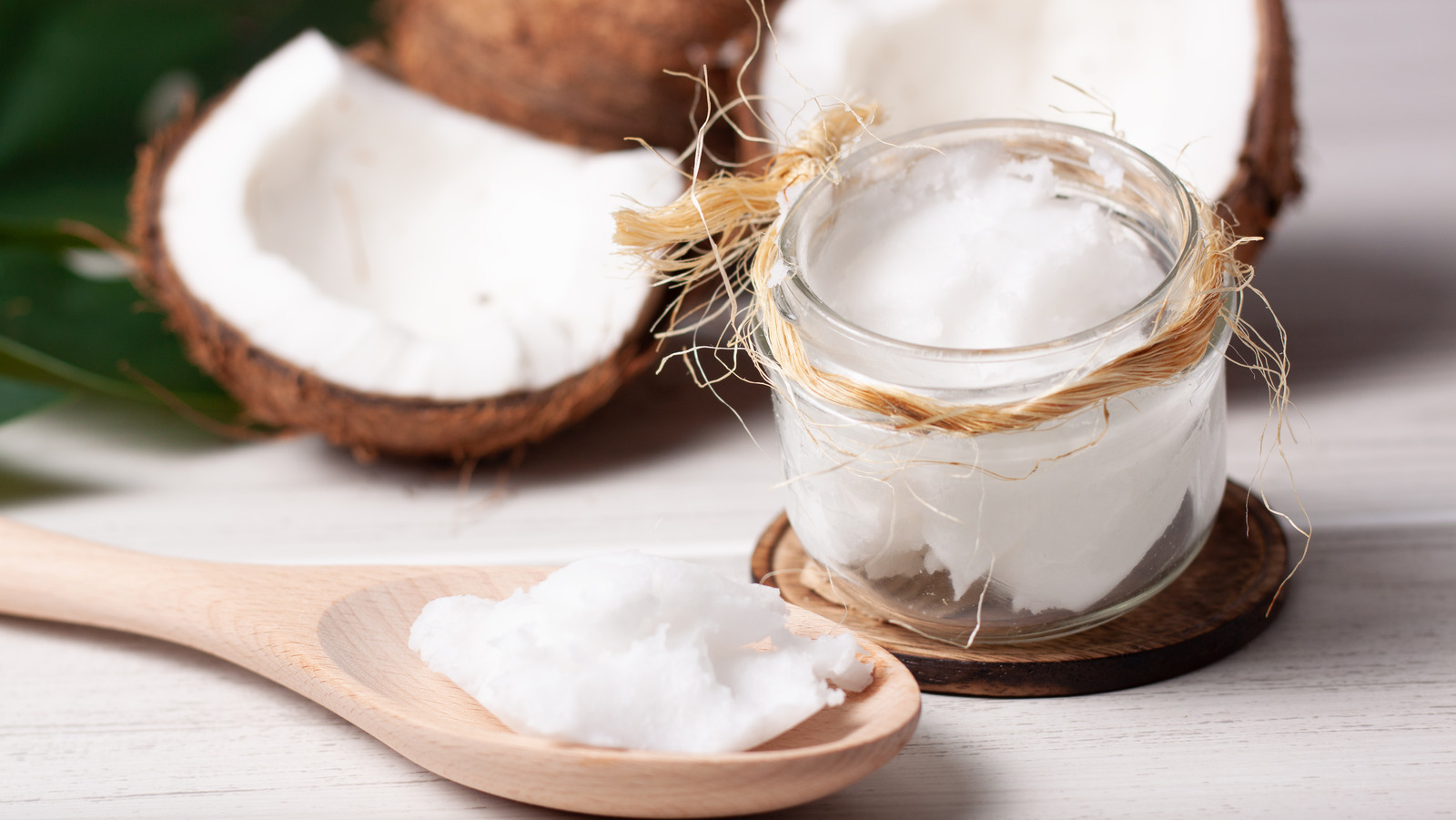When it comes to the right cooking oil for the job, the opinions on the matter are certainly varied. Some people swear by extra virgin olive oil sourced from single groves while others are happy using gallon jugs of unspecified vegetable or seed oil to do their cooking. Cost certainly comes into play but different elements such as flavor, smoke point, and health are all relevant when choosing the properties you want from your cooking oil.
You have probably come across coconut oil in the supermarket, a recipe, or in a headline extolling its virtues or faults. Coconut oil is simultaneously revered for its superfood properties and demonized for its high levels of saturated fats. As diets such as keto become more mainstream, saturated fats are no longer viewed as evil and in fact, are considered to have their own share of benefits. Nevertheless, there are a lot of factors to sift through before affirming that coconut oil is the answer to all of our problems. All the same, as long as you stick to consuming it in moderation, there are plenty of ways to use it in your cooking with optimal results. Here is everything you need to know about coconut oil.
What is coconut oil?
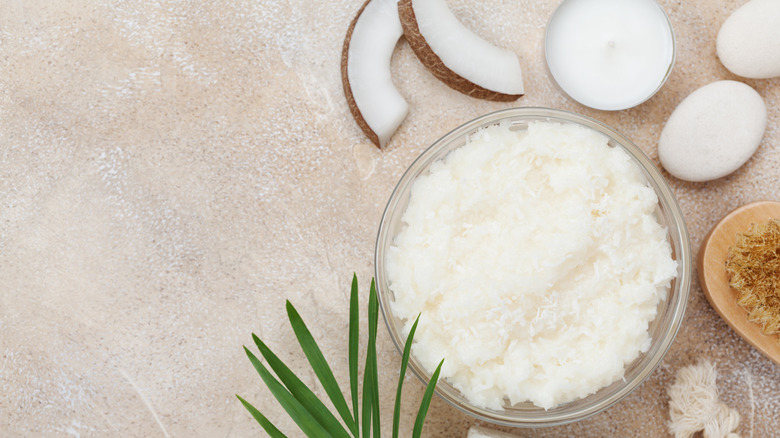
Coconut oil is a plant-based oil that is solid at room temperature thanks to its high level of saturated fats (via Harvard). With a melting point around 76 F, it can easily be used in either a solid or liquid state depending on the recipe. Coconut oil is separated from coconut meat and depending on the production method, it can have noticeable coconut aromas or taste completely neutral. This makes it suitable for cooking both sweet and savory preparations. As well, coconut oil is regularly used as a substitute for butter in vegan baking due to its solid consistency.
Aside from its benefits in the kitchen, pure coconut oil is praised for use in skin and hair care and is even thought to have antimicrobial properties (via Healthline). In countries in Southeast Asia, South America, and Polynesia, coconut oil has long been a staple (via Harvard). Nonetheless, its integration into North American cuisine is fairly recent and best done with a measured approach.
How is coconut oil made?
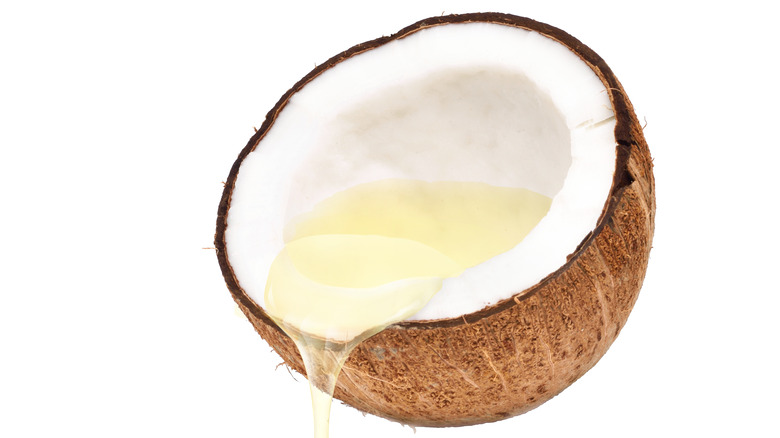
Depending on the type of coconut oil purchased, its production method will differ. The two main types are refined and unrefined coconut oil, a hint at the level of processing involved in either (via Healthline). Refined coconut oil requires more invasive techniques to separate the coconut oil from the meat. According to Harvard, heat or chemicals are used to isolate the oil, which is also filtered to remove aromas and bacteria. This results in an odorless oil that is stable at higher temperatures.
Meanwhile, unrefined or virgin coconut oil is much closer to the pure product. Here, the coconut meat is either first dried and then pressed to release the oil, or fresh coconut flesh is pressed to squeeze out the milk. Then, the milk and oil are divided using various methods including fermentation or the use of enzymes (via Harvard). Cold-pressed coconut oil is especially prized because it retains a greater amount of nutrients, antioxidants, and flavor due to the lack of heat during production (via SFGATE).
Refined vs. unrefined coconut oil
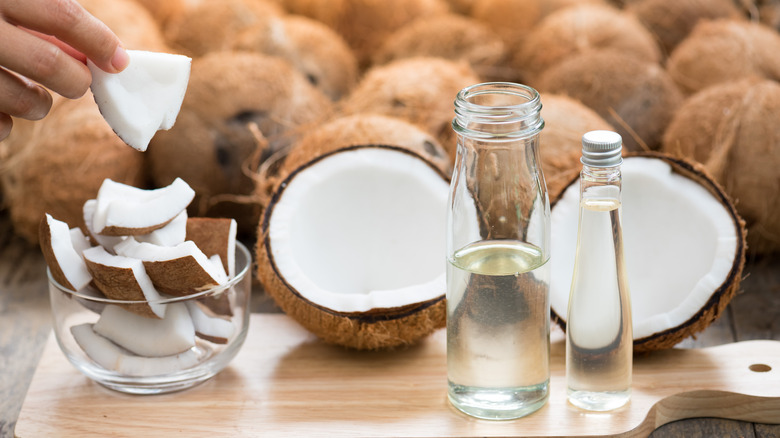
Aside from the distinct processes responsible for refined and unrefined coconut oils, the two have various characteristics that set them apart. For starters, in terms of taste and odor, unrefined or virgin coconut oil is aromatic with a definite coconut flavor. Meanwhile, refined coconut oil would be difficult to identify just from taste or smell. Consequently, each serves its own function when it comes to cooking.
Due to its processed nature, refined coconut oil has a higher smoke point (around 400 F), per The Washington Post, which means it can be used for a broader range of dishes. While it isn’t recommended as an option for deep frying, your piping hot stir-fry should do just fine. On the other hand, unrefined coconut oil has a smoke point around 350 F, making it a suitable option for baking or a light sauté. Notably, the two differ quite widely in terms of shelf life, and Harvard notes that if it is well stored, pure unrefined coconut oil will long outlive its more processed counterpart.
Although Greatist reports that refined and unrefined coconut oils are essentially nutritionally equivalent, there are some additional considerations that make unrefined coconut oil a healthier choice. If you have the extra cash to shell out, then you can be confident that there is nothing beyond coconut in your unrefined coconut oil.
What does coconut oil taste like?
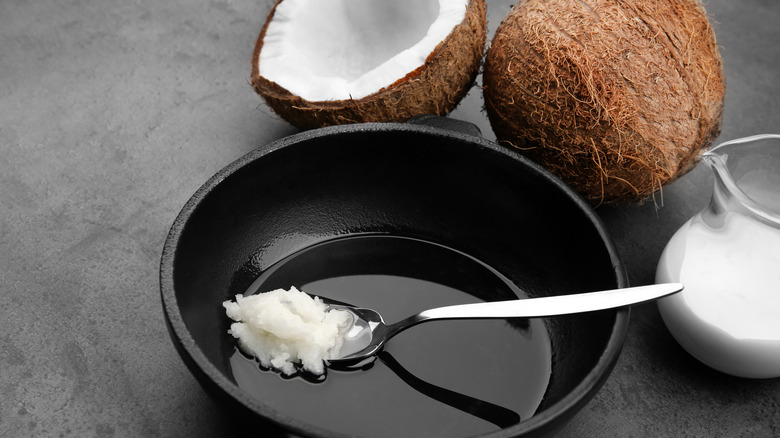
Africa Studio/Shutterstock
The flavor of coconut oil varies depending on the processing method used for its production. Epicurious explains that unrefined versions undergo a far milder technique that retains the flavor properties of the coconut. In turn, you can actually taste the tropical origin of the oil which will certainly win over fans of coconut. A warm nutty vanilla undertone is also present, which makes a great pairing for baked goods.
Meanwhile, Epicurious describes the process to produce refined coconut oil as one which ultimately strips away all of the coconut aspects of the oil. As a result, it often doesn’t taste like much at all, which makes it a better option for when you want a neutral oil (perhaps as a vegetable oil substitute) for cooking. If you are planning to use coconut oil for a stir-fry or savory dish, then your best bet is to use a refined oil.
What recipes work best with coconut oil?
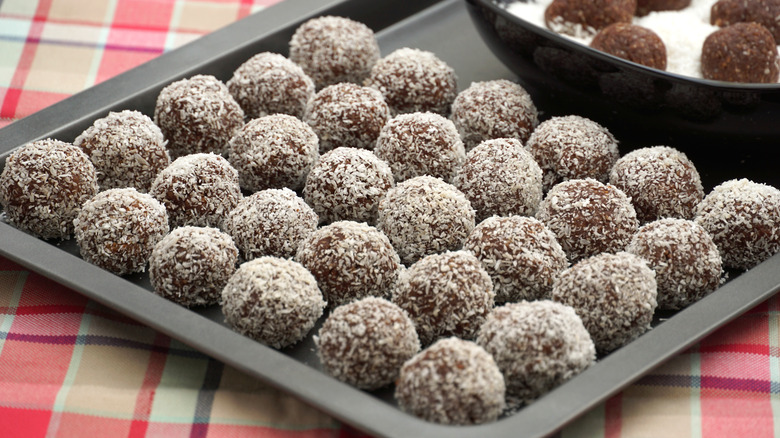
Since coconut oil can be used in a solid and liquid state, it has a wide range of applications in the kitchen. It is an excellent option for people who don’t want to consume dairy or soy and want a plant-based alternative. Baked goods are successful when coconut oil is used as a substitute for butter, though The Kitchn recommends using it in a solid state to best mimic the consistency. However, if the recipe calls for oil or butter in a liquid state, Organic Authority reports that coconut oil can be used at a one-to-one ratio. Nonetheless, you may go through some trial and error if you are replacing butter or oil with coconut oil. Due to coconut oil’s high fat content, you may find that reducing the quantity by a quarter works best.
Thanks to its solid texture at room temperature, coconut oil is a great choice for raw desserts that require binding fat. In particular, if you use an unrefined oil, then your no-bake cookies will have the additional taste of coconut. Similarly, it is a great option for making granola that will maintain its consistency at room temperature. Besides sweet preparations, coconut oil’s higher than average smoke point makes it an acceptable choice for sautéing and light stir-frying.
What recipes should not use coconut oil?
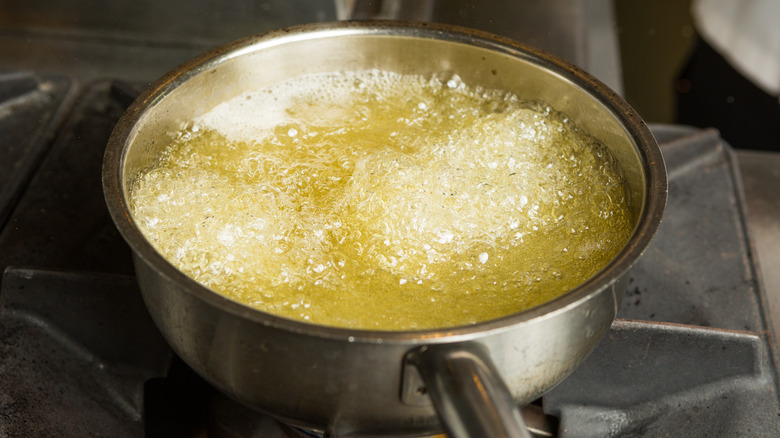
If you plan to heat coconut oil above 350 F, be sure to use a refined product which has a smoke point of about 400 F. Nonetheless, if you do plan to deep fry at higher temperatures, The Cut recommends opting for canola or vegetable oil which have smoke points between 400 and 450 F, to prevent the release of unhealthy compounds.
Since coconut oil shifts from solid to liquid state depending on its temperature, it may sometimes behave unexpectedly. For example, The Kitchn explains that if you mix melted coconut oil with cold ingredients, such as eggs or milk, straight from the refrigerator, the quick change in temperature will cause the oil to harden and create lumps. Consequently, if you are baking with melted coconut oil, bring the other ingredients to room temperature before combining them. Similarly, you won’t want to use coconut oil in a marinade or salad dressing since it will quickly harden at room temperature — not so appetizing!
Should you use coconut oil in solid or liquid form?
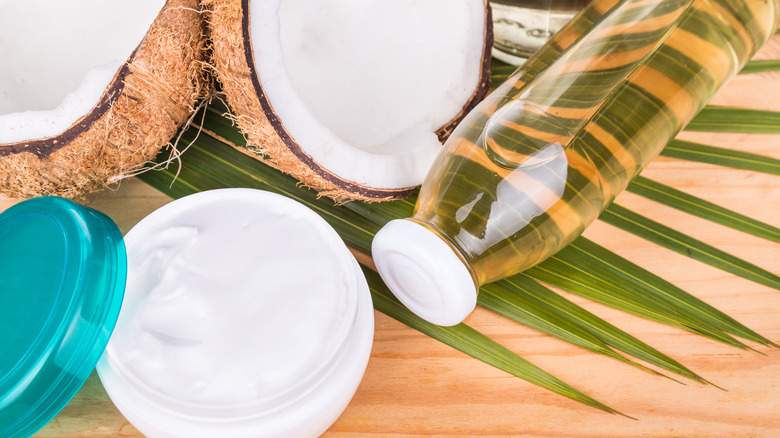
Coconut oil can be used in both solid or liquid form and the recipe you are following will generally dictate which is preferred. For instance, if you are using coconut oil to substitute butter in a baked good, use the same state as what is listed in the recipe for optimal results. If the recipe doesn’t specify, Simply Recipes notes that you can use melted coconut oil for cakes and cookies. The easiest way to quickly melt coconut oil is in the microwave in short increments to avoid making a mess.
You will notice that it is far easier to accurately measure the oil when it is melted. However, if you need to measure solid coconut oil, Organic Authority suggests buying sticks of coconut oil that come already portioned for this very purpose. As always, if you are using melted coconut oil, be sure to bring the other ingredients to room temperature before mixing them together in order to retain the appropriate consistency. If you are just using coconut oil to cook in a pan on the stovetop, a spoonful in its solid state will quickly start to melt once it heats up.
How does coconut oil compare to other cooking oils?
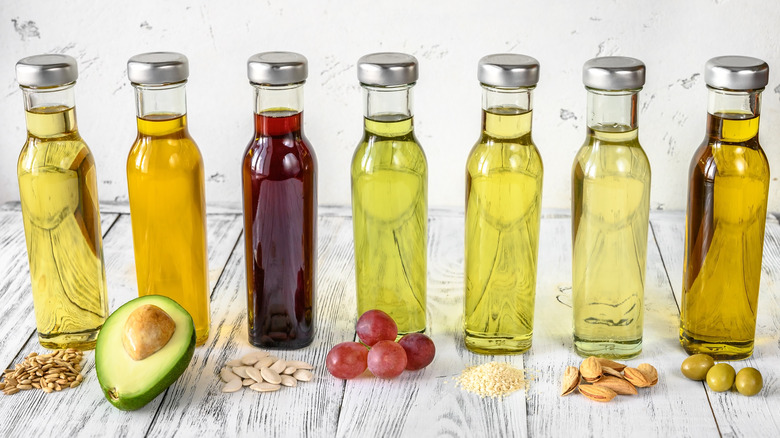
There are many ways to compare cooking oils such as how well they tolerate heat, flavor, cost, and health factors. Time explains that due to its high saturated fat content, coconut oil tolerates heat better than olive oil, for example, which makes it appropriate for certain preparations. Meanwhile, that olive oil contains high levels of healthy monounsaturated fats which are considered beneficial for the heart. As well, the BBC reports high levels of antioxidants, vitamins, and minerals found in extra virgin olive oil, making it a great choice for anything besides cooking at high heat.
The American Heart Association recommends prioritizing oils low in saturated fat and higher in mono or polyunsaturated fats such as canola, corn, olive, and sunflower. However, once again, fat content is only one part of the story, and vegetable and seed oils generally undergo a great deal of processing which strips away some of their nutrients (via Time). Avocado oil is praised for its heart-healthy fat content, mild flavor, and ability to withstand heat, however it tends to be a fair deal more expensive than other oils. As with most facets of a balanced diet, variety is key. Aim to have a few different types of oil on hand so that you can use the best one for the task.
Is coconut oil the same as MCT oil?
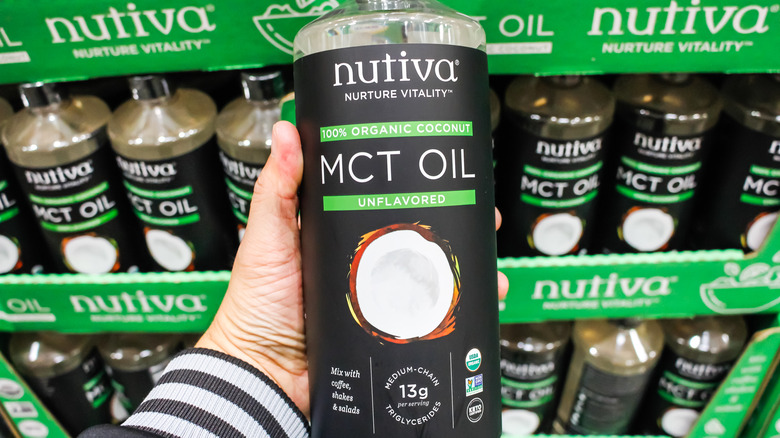
Unfortunately, a lot of coconut oil’s praise is misguided and should in fact be directed towards MCT oil. MCTs (medium-chain triglycerides) are a type of saturated fat that is quickly absorbed by the body, providing an immediate source of energy (via Healthline). For this reason, MCTs are key components of keto diets that prioritize consuming fat. Harvard reports that although it is theorized that minimal fat storage occurs with MCTs, there is no equivalent statement that can be made regarding coconut oil. Most coconut oil found in stores contains marginal amounts of pure MCTs, and instead consists of long-chain triglycerides, namely lauric acid.
Healthline indicates that of the 54% of MCT content in coconut oil, 42% is made up of lauric acid. This type of saturated fat behaves distinctly and is digested at a much slower pace. Consequently, the quick fat-burning qualities of coconut oil are ungrounded as this property does not overlap with MCTs.
How does the smoke point influence how you can use coconut oil?
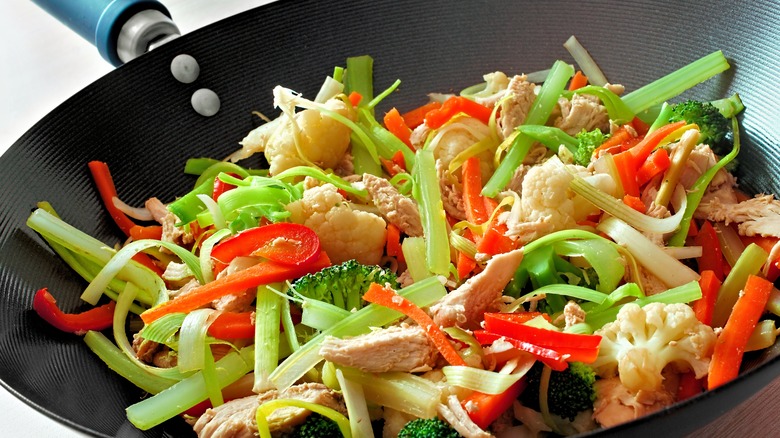
It shouldn’t come as a surprise that an oil’s smoke point is the temperature at which it starts to smoke (via Serious Eats). For the most part, once oil reaches this point it begins to break down into unstable components that are less than desirable. Consequently, it’s important to avoid bringing oils beyond a certain heat to prevent this degradation.
When it comes to coconut oil, refined and unrefined versions undergo a different series of processing steps. Accordingly, refined products eliminate elements that are more sensitive to heat. As a result of these differences, if you plan to use coconut oil at a higher heat such as to make a stir-fry, opt for refined oil. Meanwhile, unrefined oil is a great choice for cooking at lower heat, for example, if you are baking. If you plan to use coconut oil for a number of cooking applications, it’s a good idea to have both types available.
What are common mistakes when using coconut oil?
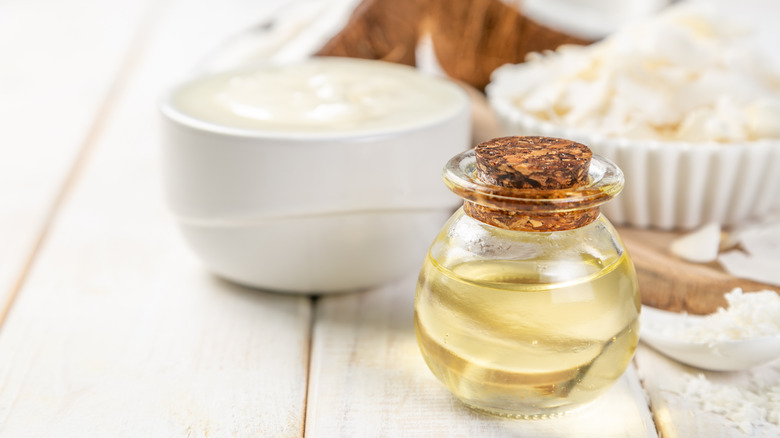
The main issues when cooking with coconut oil involve overheating it or using it in an unsuitable application. Unrefined coconut oil should not be heated above 350 F and refined ones should not exceed 400 F to prevent smoking. Not only will your food taste burnt, but The Healthy explains that harmful compounds are released into your food and the environment.
Once you are familiar with the best uses for your coconut oil, you shouldn’t come across too many issues. However, keep in mind that it can harden pretty quickly if the ambient temperature is below 76 F which can be an issue if you are combining it with cooler ingredients. On that note, if your recipe requires solid coconut oil, be sure to use solid and not liquid oil or your final product might have the wrong consistency. Even though coconut oil can successfully replace butter and other oils, it is not always completely interchangeable and Chowhound recommends making some adjustments. A one-to-one ratio should be fine for butter and oils, however, if you are substituting shortening, use about one quarter less coconut oil.
What is coconut oil’s nutritional profile?
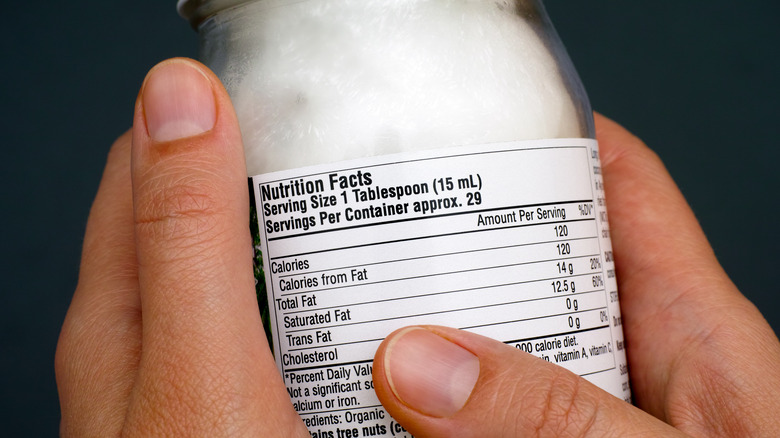
Coconut oil is pure fat and unlike most plant-based oils, Harvard indicates that it contains 80 to 90% saturated fats. Due to its composition, the oil is solid at room temperature, another anomaly among plant oils. With regards to the saturated fat content, it is further broken down and contains a large amount of lauric acid which is defined as a long-chain fatty acid. The remaining fat content contains minute amounts of monounsaturated and polyunsaturated heart-healthy fats, according to the “Encyclopedia of Food Sciences and Nutrition.”
The USDA reports that one tablespoon of coconut oil contains 120 calories and 13.5 grams of fat, 11 of which are saturated. The guidelines recommended by the American Heart Association advise no more than 12 grams of saturated fat per day, barely more than one tablespoon of coconut oil. Aside from fat and more fat, coconut oil doesn’t contain any significant levels of vitamins or minerals.
What controversies surround health claims about coconut oil?

Even though saturated fat is no longer considered to be completely harmful, the American Heart Association still recommends limiting its consumption. Since coconut oil consists of 80 to 90% saturated fat, it follows that it should be consumed in moderation. However, the confounding overlap with MCTs means that some people are adding coconut oil to everything in the hopes of improving their health. For starters, any potential weight loss properties focus on MCTs which are rapidly absorbed by the body as energy, and the British Nutrition Foundation reports no evidence demonstrating the same outcome with regular coconut oil.
People in favor of the oil praise its ability to raise HDL cholesterol which is associated with positive health outcomes. However, the accolades fail to mention the fact that the lauric acid in coconut oil simultaneously increases LDL cholesterol which heightens the risk of heart disease and stroke, according to the CDC. Lauric acid in its purest form has some antimicrobial and anti-inflammatory qualities, but these don’t extend to the diluted quantities found in coconut oil (via The Guardian). While it is fine to incorporate coconut oil into your cooking repertoire, avoid using it as though it were a superfood.
Buying and storing coconut oil
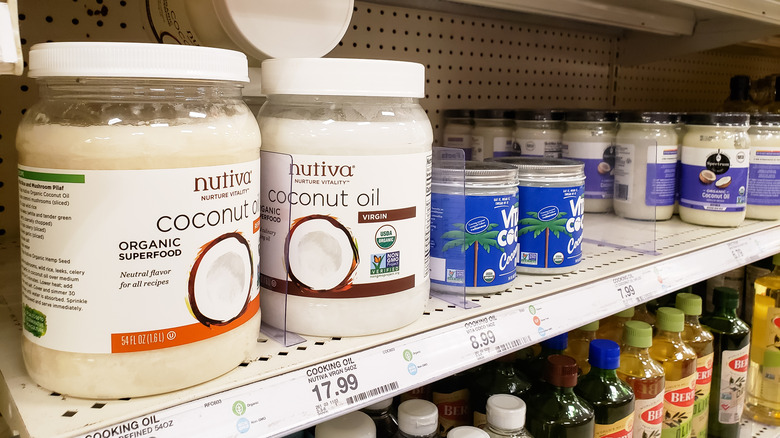
If you are eager to incorporate coconut oil into your cooking, then you will appreciate that it can be found with relative ease. Most supermarkets stock at least one type of coconut oil, and specialty shops might have options including refined, unrefined, organic, and GMO-free. You might find labels denoting virgin or extra-virgin properties, but there is no actual USDA definition of either term when it comes to coconut oil, aka, it’s just marketing.
If you don’t plan to use the oil regularly, storing it in the refrigerator will prolong its shelf life. However, keep in mind that it will be completely solid and require softening before use. If your home is regularly above 76 F, it may soften or turn to liquid due to the oil’s melting point. According to Street Smart Kitchen, refined oil will keep for up to 18 months whereas unrefined will last a few years if it has been correctly stored. Keep the oil away from direct light to prevent spoilage — you will know if the color starts to turn yellow and an unpleasant rancid smell develops (via Harvard).



